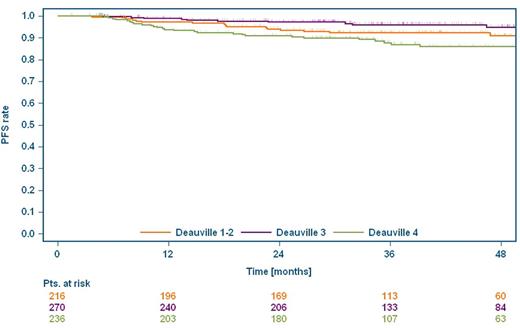Abstract
Background:
In our GHSG HD18 study for patients with newly diagnosed advanced-stage Hodgkin's lymphoma (HL), we used early interim positron emission tomography after 2 cycles of eBEACOPP (PET-2) to guide further treatment. In contrast to other groups, we defined a Deauville score at interim staging (iDS) ≥ 3 as positive. The prognostic impact of PET-2 in the context of eBEACOPP was and still is unclear, however. We thus investigated its association with baseline characteristics and treatment outcome in patients treated with eBEACOPP in our international phase 3 HD18 trial (NCT00515554).
Methods:
We recruited 2101 patients aged 18-60 years between 05/2008 and 07/2014. All patients received 2xeBEACOPP followed by centrally assessed PET-2, determining the iDS ranging from 1 (no FDG uptake) to 4 (FDG uptake above liver). Before 06/2011, patients were randomized 1:1 between 8xeBEACOPP and experimental treatment depending on iDS. After 06/2011, patients with iDS 1-2 were randomized 1:1 between 6xeBEACOPP and 4xeBEACOPP treatment, while all patients with iDS 3-4 received 6xeBEACOPP. Radiotherapy was recommended in case of residual lesions with DS ≥ 3 (until 04/2014)/ DS 4 (after 04/2014) after chemotherapy.
We explored the association of iDS with baseline characteristics, and assessed treatment outcomes according to iDS among patients treated with 6xeBEACOPP within our trial after 06/2011, considering different cutoffs for positivity. We applied means of descriptive statistics, Fisher's exact test and multivariate logistic regression, and analyzed survival outcomes according to Kaplan-Meier, using Cox regression for comparisons.
Findings:
Among 1945 randomized patients, 1005 (52%), 471 (24%) and 469 (24%) had iDS 1-2, 3 and 4, respectively, according to central review of PET-2.
Many clinical risk factors were associated with an unfavorable iDS, including adverse performance status, high international prognostic score (IPS) and the presence of large mediastinal mass (LMM), extranodal disease, 3 or more nodal areas and elevated ESR. Since patients with clinical stage (CS) IIB were only qualified for the trial when presenting with a large mediastinal mass, they had a high iDS more often than patients with CS III or IV or without B symptoms. Accordingly, in a multivariate analysis including all factors with univariate p<0.001, only LMM, extranodal involvement and a high IPS remained significant.
After 06/2011, 216 patients with iDS 1-2 and all 506 patients with iDS 3-4 were assigned to receive 6xeBEACOPP. Among those 722 patients, PET after chemotherapy due to the presence of residual lesions was done in 83 (38%), 204 (76%) and 188 (80%) of patients with iDS of 1-2, 3, and 4, respectively, and FDG uptake above the liver (DS4) was observed in 3 (1%), 19 (7%) and 73 (31%), respectively (p<0.0001 each). Radiotherapy was performed in 9 (4%), 89 (33%) and 108 (46%), respectively (p<0.0001). With a median observation time of 37 months, 3-year PFS was 92.2%, 95.9% and 87.6% with iDS 1-2, 3 and 4, respectively (figure 1). The Hazard Ratio (HR) for iDS 3-4 vs. 1-2 was 1.1 (95% CI 0.6-1.9, p=0.8), but for iDS 4 vs. 1-3 it was 2.3 (95% CI 1.3-3.8, p=0.002). When including the associated baseline factors LMM, extranodal involvement and elevated IPS, the effect of iDS 4 remained significant (HR 2.4, 95% CI 1.4-4.1, p=0.002). Overall survival after 3 years was 97.6%, 99.0% and 96.8% with iDS of 1-2, 3 and 4, respectively, with a univariate HR for score 3-4 vs. 1-2 of 0.9 (95% CI 0.3-2.3, p=0.8) and for score 4 vs. 1-3 of 2.6 (95% CI 1.0-6.6, p=0.04). In the multivariate model, the effect of iDS 4 was even more pronounced (HR 3.2, 95% CI 1.3-8.3, p=0.02).
Conclusion:
The Deauville score after 2xeBEACOPP is associated with many clinical risk factors at baseline. For patients treated with 6xeBEACOPP followed by irradiation of PET-positive residuals, iDS 3 does not indicate an increased risk of treatment failure and is associated with long-term outcomes identical to those after clearly negative PET-2 (iDS 1-2). DS 4 at PET-2 adds some prognostic information to the baseline risk factors, but 3-year outcomes do not suggest a need for treatment intensification beyond standard therapy. Based on these results, the GHSG has decided to adopt the more widely used cutoff of iDS 4 for PET positivity. Thereby, about 75% of patients could take advantage of the abbreviated treatment with only 4 cycles of eBEACOPP in a PET-2-guided approach as defined in the HD18 study.
Borchmann: Novartis Pharmaceuticals Corporation: Honoraria. Greil: Takeda: Honoraria, Research Funding; Roche: Honoraria, Membership on an entity's Board of Directors or advisory committees, Other: travel support, Research Funding; Novartis, Celgene: Research Funding; BMS, Amgen: Honoraria. Meissner: Takeda: Other: Non-Financial Support; BMS: Other: Non-Financial Support; Celgene: Other: Non-Financial Support; Amgen: Other: Non-Financial Support. Krause: Novartis: Honoraria. Engert: Affimed: Consultancy, Research Funding; Amgen: Consultancy, Research Funding; Bristol-Meyers Squibb: Consultancy, Research Funding; Takeda Oncology: Consultancy, Research Funding.
Author notes
Asterisk with author names denotes non-ASH members.


This feature is available to Subscribers Only
Sign In or Create an Account Close Modal